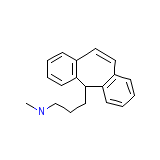Rhotrimine




Rhotrimine Brand names, Rhotrimine Analogs
Rhotrimine Brand Names Mixture
- No information avaliable
Rhotrimine Chemical_Formula
C19H21N
Rhotrimine RX_link
No information avaliable
Rhotrimine fda sheet
Rhotrimine msds (material safety sheet)
Rhotrimine Synthesis Reference
Engelhardt, Christy Belg. pat. 617,967, C.A. 59, 517f (1963)
Rhotrimine Molecular Weight
263.377 g/mol
Rhotrimine Melting Point
169-171 oC (Protriptyline HCl)
Rhotrimine H2O Solubility
1.04 mg/L
Rhotrimine State
Solid
Rhotrimine LogP
4.987
Rhotrimine Dosage Forms
Tablet
Rhotrimine Indication
For the treatment of depression and obsessive-compulsive disorders.
Rhotrimine Pharmacology
Protriptyline is a tricyclic antidepressant. It was thought that tricylic antidepressants work by inhibiting the re-uptake of the neurotransmitters norepinephrine and serotonin by nerve cells. However, this response occurs immediately, yet mood does not lift for around two weeks. It is now thought that changes occur in receptor sensitivity in the cerebral cortex and hippocampus. The hippocampus is part of the limbic system, a part of the brain involved in emotions. Presynaptic receptors are affected: a1 and b1 receptors are sensitized, a2 receptors are desensitised (leading to increased noradrenaline production). Tricyclics are also known as effective analgesics for different types of pain, especially neuropathic or neuralgic pain. A precise mechanism for their analgesic action is unknown, but it is thought that they modulate anti-pain opioid systems in the CNS via an indirect serotonergic route. They are also effective in migraine prophylaxis, but not in abortion of acute migraine attack. The mechanism of their anti-migraine action is also thought to be serotonergic.
Rhotrimine Absorption
No information avaliable
Rhotrimine side effects and Toxicity
Side effects include anxiety, blood disorders, confusion, decreased libido, dizziness, flushing, headache, impotence, insomnia, low blood pressure, nightmares, rapid or irregular heartbeat, rash, seizures, sensitivity to sunlight, stomach and intestinal problems.
Rhotrimine Patient Information
PATIENT INFORMATION
Protriptyline is used to treat the symptoms of mental depression in people who are under close medical supervision. It is particularly suitable for those who are inactive and withdrawn.
Protriptyline is a tricyclic antidepressants. Unlike the class of antidepressants known as monoamine oxidase (MAO) inhibitors, it does not act primarily through stimulation of the central nervous system. It tends to work more rapidly than some other tricyclic antidepressants. Improvement sometimes begins within a week.
If you are prone to anxiety or agitation, Protriptyline can make the problem worse. It can also exaggerate the symptoms of manic-depression and schizophrenia.
Protriptyline must never be taken with drugs classified as monoamine oxidase (MAO) inhibitors, such as the antidepressants Nardil and Parnate.
Protriptyline should be used with caution by people who have heart problems or a thyroid disorder.
Take precaution if you have a history of seizures, difficulty urinating, or glaucoma (high pressure in the eyes); or use alcohol excessively while taking Protriptyline.
Protriptyline is used to treat the symptoms of mental depression in people who are under close medical supervision. It is particularly suitable for those who are inactive and withdrawn.
Protriptyline is a tricyclic antidepressants. Unlike the class of antidepressants known as monoamine oxidase (MAO) inhibitors, it does not act primarily through stimulation of the central nervous system. It tends to work more rapidly than some other tricyclic antidepressants. Improvement sometimes begins within a week.
If you are prone to anxiety or agitation, Protriptyline can make the problem worse. It can also exaggerate the symptoms of manic-depression and schizophrenia.
Protriptyline must never be taken with drugs classified as monoamine oxidase (MAO) inhibitors, such as the antidepressants Nardil and Parnate.
Protriptyline should be used with caution by people who have heart problems or a thyroid disorder.
Take precaution if you have a history of seizures, difficulty urinating, or glaucoma (high pressure in the eyes); or use alcohol excessively while taking Protriptyline.
Rhotrimine Organisms Affected
Humans and other mammals














